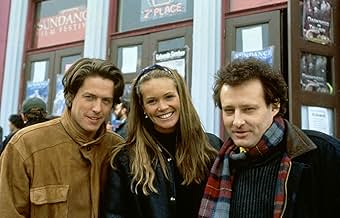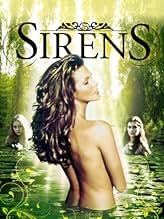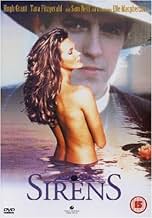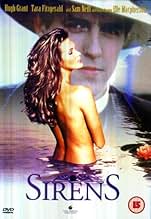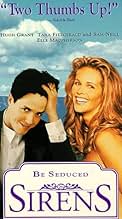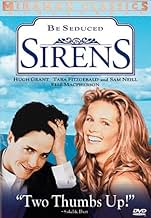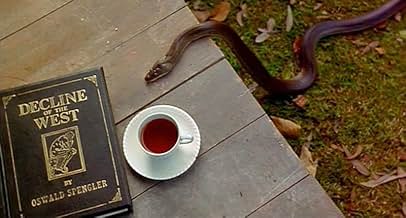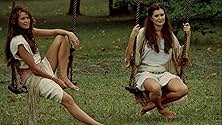IMDb RATING
5.9/10
12K
YOUR RATING
When a painting is termed blasphemous, a young minister and his wife visit the artist... and the three sexually playful models living with him.When a painting is termed blasphemous, a young minister and his wife visit the artist... and the three sexually playful models living with him.When a painting is termed blasphemous, a young minister and his wife visit the artist... and the three sexually playful models living with him.
- Awards
- 1 win & 4 nominations total
Tziporah Malkah
- Pru
- (as Kate Fischer)
- Director
- Writer
- All cast & crew
- Production, box office & more at IMDbPro
Featured reviews
Having lived through similar experiences while in my late 20's, early 30's I found the movie both entertaining as well as sensitive. I suppose there could have been more graphic scenes for those of a more shallow nature needing to see some models naked and doing more, but that was not necessary for my wife and I to enjoy it- having been there, we knew what was not pictured.
Men, like the Preacher, often fail to see the sensuous side of women, either that or it frightens them. They see "sex" when they should be seeing loving and caring. The movie illustrates that nicely. The two townsmen who come to visit the models are a clear example of sex versus loving and sensuality. The clueless type is the Preacher.
Men, like the Preacher, often fail to see the sensuous side of women, either that or it frightens them. They see "sex" when they should be seeing loving and caring. The movie illustrates that nicely. The two townsmen who come to visit the models are a clear example of sex versus loving and sensuality. The clueless type is the Preacher.
I absolutely love this truly erotic film. An exploration of the awakening of a woman's sexuality, it is beautifully filmed and acted, and has many moments of wit and humour.
Some reviewers object to the heavily laden symbolism attributed to various parts, such as the shots of the snake. Well, symbolism is part of what good writers refer to as "subtext", it isn't too often seen these days, and is at least part of an attempt to have the film say more than what the characters say to each other. This is an artistically valid thing for any film to do, and raises the level of film culture generally, if only a little.
I have yet to see anyone commenting on the superb score - this wonderful music by Rachel Portman (whose work I otherwise do not know) is a delight from start to finish, and unlike most movie music, would stand on its own as a concert piece. The main theme, quirky, cheerful and rhythmically very interesting, seems to take as its inspiration the Vaughan Williams "March of the Kitchen Utensils" heard at the very start of the film as we follow Hugh Grant's feet walking through the art gallery, but it is very much an excellent piece of music in its own right. The "Dream Variations" are suitably dreamy, and coupled with the slow motion photography make for a superb piece of cinema.
John Duigan (writer, director) is not often mentioned in the same breath as other well known Australian directors such as George Miller or Peter Weir or Bruce Beresford, but personally I think he stands up with the best of them. A true Auteur (he has scripted most of the films he has directed) his films are always very interesting character studies. A more well known recent film he made was "The Leading Man" which starred Jon Bon Jovi as an American actor who comes to London to appear in a West End Play, and is "hired" by the director to seduce his wife. As in The Leading Man, Sirens is about the interactions between characters, this providing in my view more than enough in the way of plot and sub-plot. If Duigan's films always seem to be about human sexuality, well, after all, that is what drives most human relationships, whether we want to admit it or not. I think what stands out about Duigan's films, and particularly about Sirens, is their total honesty about human sexuality, without (and I know some will disagree) being excessively prurient.
A final line - I love the helicopter shot at the very, very end of the film. It is a beautiful, painterly landscape scene (which fades out *just* too soon), but one's love of its beauty is strengthened by one's admiration of the five actresses, who had to climb to the top of this sheer-looking rocky outcrop and remove all their clothes for the shot! They have my appreciation, and my sympathy!
Some reviewers object to the heavily laden symbolism attributed to various parts, such as the shots of the snake. Well, symbolism is part of what good writers refer to as "subtext", it isn't too often seen these days, and is at least part of an attempt to have the film say more than what the characters say to each other. This is an artistically valid thing for any film to do, and raises the level of film culture generally, if only a little.
I have yet to see anyone commenting on the superb score - this wonderful music by Rachel Portman (whose work I otherwise do not know) is a delight from start to finish, and unlike most movie music, would stand on its own as a concert piece. The main theme, quirky, cheerful and rhythmically very interesting, seems to take as its inspiration the Vaughan Williams "March of the Kitchen Utensils" heard at the very start of the film as we follow Hugh Grant's feet walking through the art gallery, but it is very much an excellent piece of music in its own right. The "Dream Variations" are suitably dreamy, and coupled with the slow motion photography make for a superb piece of cinema.
John Duigan (writer, director) is not often mentioned in the same breath as other well known Australian directors such as George Miller or Peter Weir or Bruce Beresford, but personally I think he stands up with the best of them. A true Auteur (he has scripted most of the films he has directed) his films are always very interesting character studies. A more well known recent film he made was "The Leading Man" which starred Jon Bon Jovi as an American actor who comes to London to appear in a West End Play, and is "hired" by the director to seduce his wife. As in The Leading Man, Sirens is about the interactions between characters, this providing in my view more than enough in the way of plot and sub-plot. If Duigan's films always seem to be about human sexuality, well, after all, that is what drives most human relationships, whether we want to admit it or not. I think what stands out about Duigan's films, and particularly about Sirens, is their total honesty about human sexuality, without (and I know some will disagree) being excessively prurient.
A final line - I love the helicopter shot at the very, very end of the film. It is a beautiful, painterly landscape scene (which fades out *just* too soon), but one's love of its beauty is strengthened by one's admiration of the five actresses, who had to climb to the top of this sheer-looking rocky outcrop and remove all their clothes for the shot! They have my appreciation, and my sympathy!
This movie was a nice surprise to me. I expected something more raunchy, considering it's reputation with a lot of naked women (all gorgeus by the way). Instead, I found it to be a sweet and unexpectedly innocent movie about being yourself, accepting who you are, exploring your possibilities. Tara Fitzgerald is simple super as the curious wife of Hugh Grant's vicar (who seems to be constantly blushing and who is his usual bumbling self). She simply has the meatiest part and she surely takes advantage of that. All the "naked ladies" deliver very respectable performances. Only Sam Neill seems to be a bit too lost amid all these different personalities and doesn't really convince. Absolutely stunning visuals (it's shot in Australia, but apart from the odd scenes at a bar, it all seems to take place in some gorgeus never-never land). And the nudity didn't disturbed me one bit since it's presented in a very unaffected and natural way. Truly different and very refreshing!
I never heard of this film until the director for our theater company mentioned it as a possible project to adapt to live theater. I have to say when I first viewed the film I was a bit shocked for personal reasons. We have a fairly small group and if taken directly it would mean I would be playing one of the nude models. After studying the film's critiques and background I slowly came around to appreciate the film's merits, if not completely comfortable with the nudity. The point is that the nudity is not suppose to be comfortable from the audience point of view. The story takes place in an almost mystical world untarnished by outside influences and taboos. It is indeed a wonderful Eden. As an actress I had to be comfortable within the Eden created on stage, despite being uncomfortable in front of fellow "actors" and the audience. This has become one of my favorite films for helping me grow as an actress and as a member of the audience.
I knew nothing about this movie, but offered to accompany a woman I had known for some time, but had never been on more than vaguely friendly terms. I was not prepared for the charm, playfulness, joy and raw sensuality that this film captured. Sam Neill is the ultimate sensualist, yet indulges his children's fancies with innocent abandon. Hugh Grant is a likable doofus, and he is far outpaced by Tara Fitzgerald's acceptance of the pleasures of the flesh. In many ways, this couple reminded me of Brad & Janet in "Rocky Horror" - the man is either unable or too clueless to accept the sensual awakening that his companion does. Thus, I was pleased at my date's choice of film, and any discomfort of my own at being seduced by the screen on a first date soon passed from my date's reactions to the sexy scenes. On the anniversary of that date, I paid the outrageous price of $59.95 for a VHS copy, and the repeat viewings were as pleasant as th first. We later married, and this was her idea, too.
P.S.: I recommend "The Advocate" for those who like "Sirens".
P.P.S.: I agree for the most part with Eamon Buchanan's comments, but, the models were "painted"in the nude, not "painting", and it was the Anglican church that was upset, not the Catholic (the Campions could not have been married if they were Catholic).
P.S.: I recommend "The Advocate" for those who like "Sirens".
P.P.S.: I agree for the most part with Eamon Buchanan's comments, but, the models were "painted"in the nude, not "painting", and it was the Anglican church that was upset, not the Catholic (the Campions could not have been married if they were Catholic).
Did you know
- TriviaAlthough this is a work of fiction, it is about a real person. Norman Lindsay was a real-life artist and author in Australia during the early 1900s. Several of his books have been adapted into movies, including Age of Consent (1969).
- GoofsThe beautiful green steam locomotive that is seen in an early scene is a NSWGR 38 class, which first entered service in 1942. ( the movie is set around the year 1930. )
- Quotes
Sheela: [Anthony has just gone to the outhouse] I should have warned him about the redbacks.
Estella Campion: What are they?
Sheela: Small spiders with big teeth. They live under toilet seats usually.
Estella Campion: How do you know if they're there?
Sheela: By the screams.
- Crazy creditsThe situations depicted in this film are fictitious and do not represent events in the lives of Rose, Norman, Jane and Honey Lindsay.
- Alternate versionsAccording to the Technical Specifications link for this page on IMDB, there are two different versions of this film: "1 hr 38 min (98 min)," and "1 hr 34 min (94 min) (Canada)."
- ConnectionsEdited from A Steam Train Passes (1974)
- SoundtracksGrey Funnel Line
Written by Cyril Tawney
Dick James Music, Ltd.
Performed by Silly Sisters
Courtesy of Chrysalis Records, Ltd.
- How long is Sirens?Powered by Alexa
Details
- Release date
- Countries of origin
- Language
- Also known as
- Sirenas
- Filming locations
- Production companies
- See more company credits at IMDbPro
Box office
- Gross US & Canada
- $7,770,731
- Opening weekend US & Canada
- $34,299
- Mar 6, 1994
- Gross worldwide
- $7,770,731
Contribute to this page
Suggest an edit or add missing content


